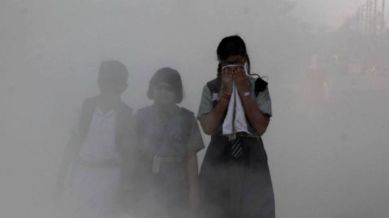Stay updated with the latest - Click here to follow us on Instagram
Delhi Air Quality Index at ‘upper end of very poor category’; transport sector major contributor to PM 2.5 level
Data from the Decision Support System (DSS) developed by the Indian Institute of Tropical Meteorology, Pune, shows that the national capital's transport sector contributed around 11.83% to PM 2.5 levels in the city on Tuesday.

As Delhi’s air quality deteriorated and stood at the upper end of the ‘very poor’ category on Wednesday morning, data showed that the city’s transport sector and emissions from other parts of the NCR have contributed the most to PM 2.5 levels.
Data from the Decision Support System (DSS) developed by the Indian Institute of Tropical Meteorology, Pune, shows that the national capital’s transport sector contributed around 11.83% to PM 2.5 levels in the city on Tuesday. It categorised the contribution from Noida to PM 2.5 levels in Delhi as 14.28%, and that from Ghaziabad as 7.99%.
monthly limit of free stories.
with an Express account.
On Wednesday, data as of 12 am, showed a contribution of 11.38% from Delhi’s transport sector, and 10.47% from Noida.
The 24-hour average AQI in Delhi was 372, in the upper end of the ‘very poor’ category, at 9 am on Wednesday, according to the Central Pollution Control Board (CPCB). The worst AQI of 435 was recorded at New Moti Bagh, followed by 422 at Anand Vihar and Wazirpur. AQI from 401 to 500 is categorised as ‘severe’, and can “affect healthy people and seriously impact those with existing diseases,” as per the CPCB.
From October 22 to November 1, the contribution of biomass burning, which is based on fire count data from satellites, to PM 2.5 levels in Delhi ranged from 23.48% on October 27 to 7.175% on October 31. As of 12 am on Wednesday, the contribution was 12.96%.
On Monday, Punjab recorded 1030 crop residue burning events, a little less than the highest single-day count so far of 1068 recorded on Sunday, data from the Indian Agricultural Research Institute showed.
A forecast issued by the Air Quality Early Warning System on Tuesday said that the air quality is likely to remain in the ‘very poor’ category from November 1 to 3, with low wind speeds prevailing.
The DSS provides information about the contribution of emissions from Delhi and 19 surrounding districts to PM 2.5 levels in Delhi. It categorises the contribution from Delhi itself into eight different sectors, including transport, construction and road dust.